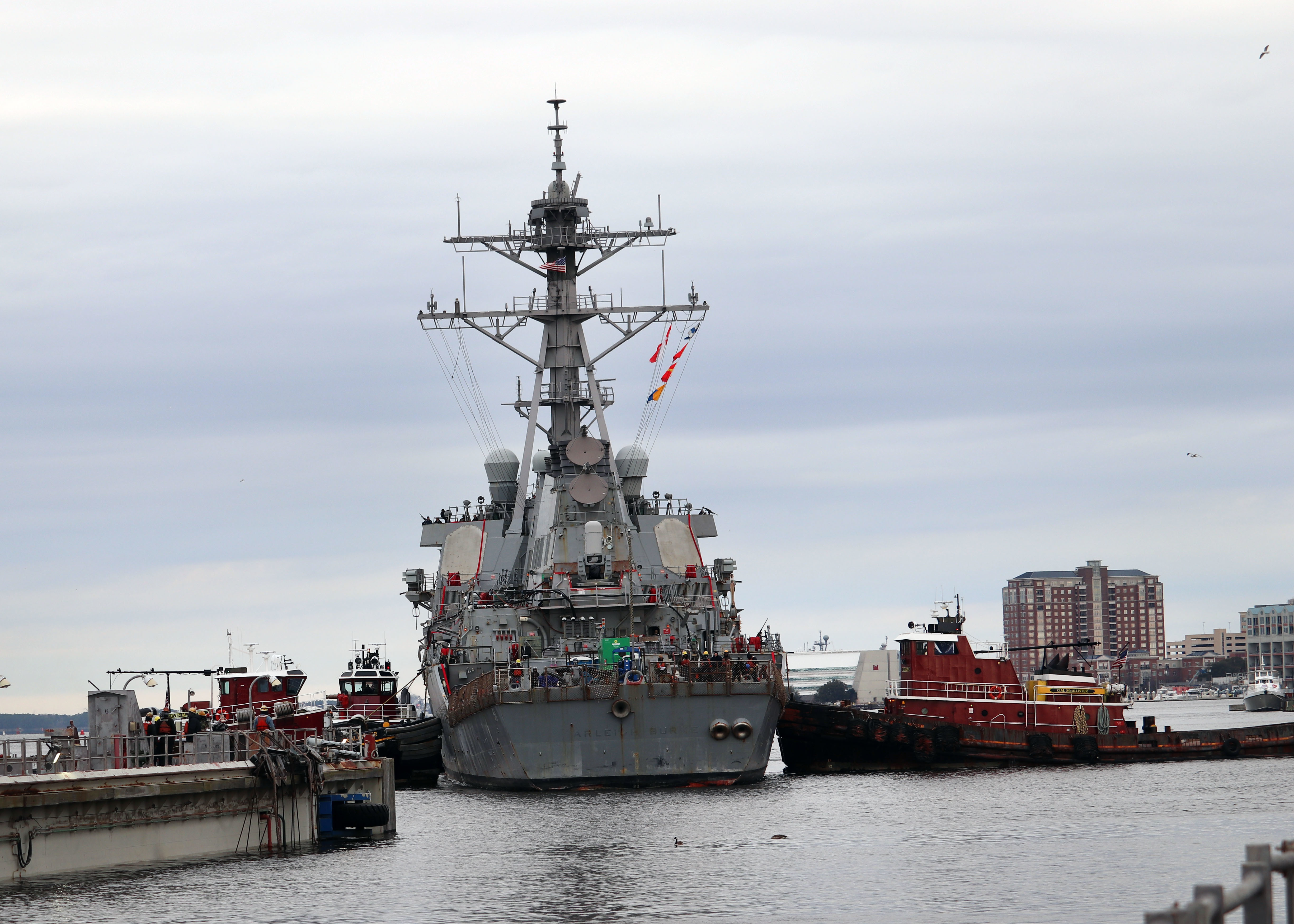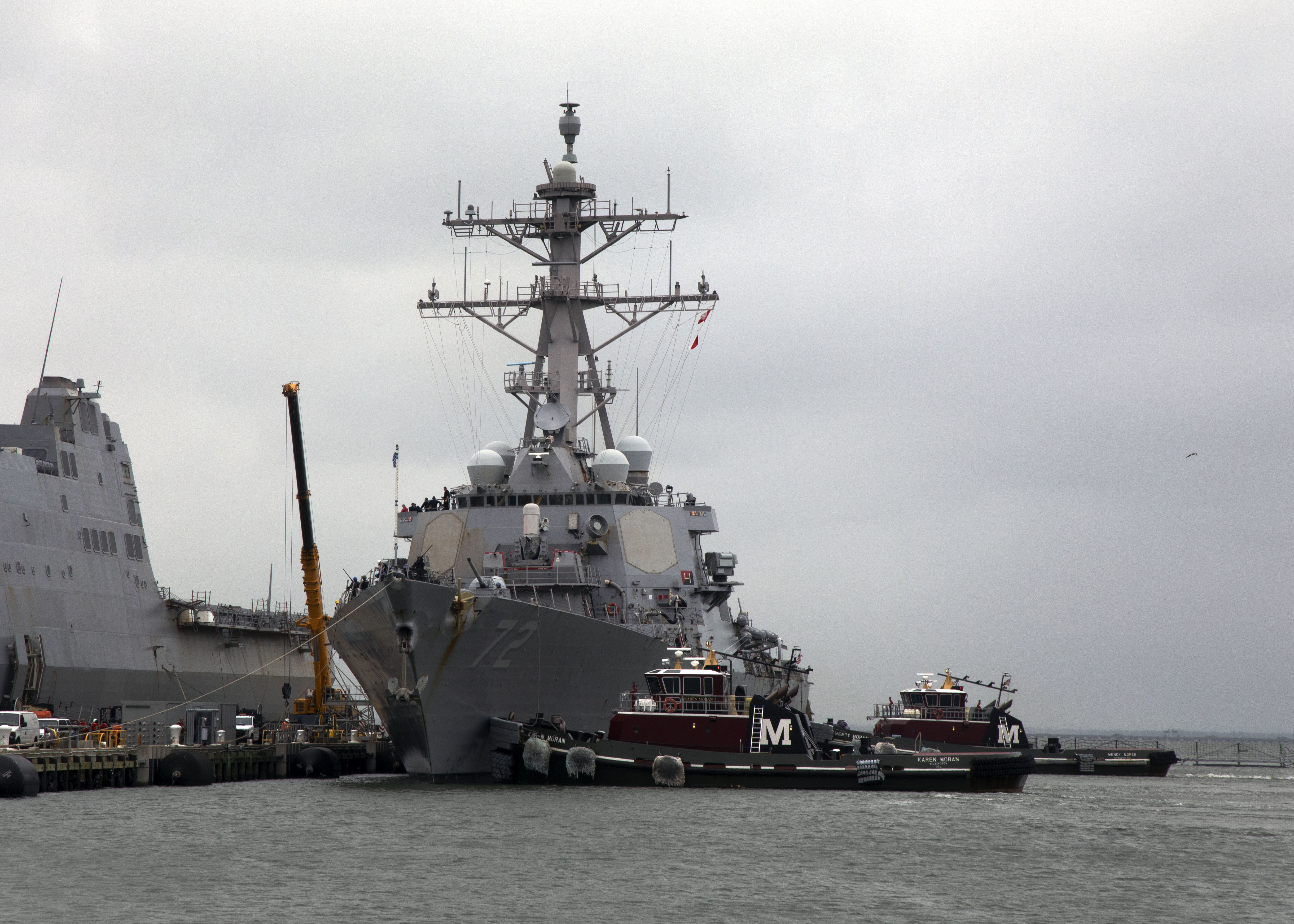
ARLINGTON, Va. – The chief of naval operations gave the Navy an aggressive goal to eliminate lost operational days from overrun maintenance availabilities by next year, and surface navy and maintenance community leadership believe they’re on track to do just that.
The Navy’s surface combatants and amphibious warships go through maintenance and modernization periods conducted by private companies and overseen by Naval Regional Maintenance Centers. In recent years, a combination of factors has led to abysmal on-time completion rates in the 20-percent range. Late contract awards, growth in the scope of work once maintainers start opening tanks and compartments, delays from material or labor shortages and more have all contributed to these rates.
And yet, CNO Adm. Mike Gilday wants to achieve zero lost operational days by the end of Fiscal Year 2021 – just 20 months from now.
“To responsibly grow and dynamically operate the fleet, we will predictably and effectively maintain the fleet – in peacetime and in support of conflict. As we have learned over the past decade, it is cheaper to maintain readiness than to buy it back. Our toughest near-term challenge is reversing the trend of delivering only 40 percent of our ships from maintenance on time,” Gilday wrote in a fragmentary order last month.
“We will further develop and implement better productivity metrics and identify the key levers to deliver all depot availabilities on time and in full. Our goal is to improve productivity, reduce lost days through depot availability extensions by 80 percent in FY20 compared with FY19, and eliminate lost days through depot extensions by the end of FY21.”
The fleet is up to the challenge, leaders said last week at the annual Surface Navy Association conference.
“If you look at 2018, 29 percent of ships came out of availabilities on time. In 2019, 43 percent of our ships came out of their availabilities on time. We are projecting for 2020 that 71 percent of those ships will come out of availabilities on time. That’s a lot of huge effort by both industry and Navy leadership to change the paradigm of how we’re doing ship maintenance,” Commander of Naval Surface Forces Vice Adm. Richard Brown said during the conference’s kickoff speech.
During a later panel, Commander of Naval Regional Maintenance Centers Rear Adm. Tom Anderson said the maintenance community was already devoting serious effort to improving on-time delivery rates out of maintenance availabilities, but he said Gilday’s latest command guidance has focused that conversation.
When talking to the RMCs he oversees and to the surface force commanders on each coast, “we’ve gone from a discussion that was kind of a generic discussion of, hey, I got a ship that’s going to be a little bit late, to, how am I going to maintain that schedule? And if I have some type of issue, how can I minimize the number of days? What’s the critical path on that ship? What are all the obstacles that I can remove?”
Anderson added that the Gilday guidance also created a “kind of urgency, that need to move out quickly and achieve results in the near-term.”
He pointed to a pilot program an RMC kicked off after noticing that the Military Sealift Command auxiliary ships could get through underwater hull coating work much faster than the Navy’s warships despite involving the same material and labor.
The admiral said the Navy asks its contractors to write a report on the condition of the underwater portion of the hull, submit it, allow the Navy to send back a marked up copy, revise the report, and then finally start the coating work months later – all in an effort for the Navy to feel assured that quality work will be done to keep its warships in good condition until the next maintenance availability. MSC, on the other hand, lets certified workers from its maintenance contractor do the work, an independent third party inspects the work, and then the contractor warrantees the work for a length of time. Anderson said this model caught the RMCs’ attention and is being tried out.

Asked if he thought these kinds of initiatives were enough to get to the 71-percent on-time delivery rate Brown expects to see this year and the end to late deliveries that Gilday expects in the coming years, Anderson expressed his confidence. He told USNI News during a question and answer session that most of the availabilities that will make or break the 71-percent rate have either started or are about to start. The maintenance community often says that good planning is the key to on-time delivery, but since these have already been planned and are relying on solid execution, Anderson said he established a director of material position on his staff to identify best practices and to focus on the status of materials and prioritizing where they should go.
“I’ll give you an example: if I have an availability that’s going on, and I need a certain valve, and that valve is late – but I have an availability that’s starting a little bit later and that valve’s already in the box – before, we weren’t going to that other box and taking the valve and using it” because ship sets were looked at individually instead of as assets for the whole RMC to tap into. “So the focus we have on material is one part of it,” he said of his effort to ensure success this fiscal year.
Additionally, high-level decision-making and accountability will also play a role. Though maintenance officials have said in the past that decisions need to be made closer to the waterfront to ensure timelier decisions – with recent efforts being made to delegate decisions down related to approving growth work and cost increases – for a short time, leaders actually want to do the opposite and get flag officers involved in making decisions.
“Sometimes 24 hours, if the right people aren’t paying attention, turns into a week, two weeks” of delay, Rear Adm. Roy Kitchener, the commander of Naval Force Atlantic, said during the panel discussion. Flag officers in the fleet and in the maintenance community – for the time being – will be looped into decisions that affect potential delays and how to mitigate them or whether to accept the delay with the understanding of what risk it poses to the operational fleet.
Both Kitchener and Anderson agreed this approach wasn’t sustainable in the long run, but the hope is that today’s flag officers will set precedent for how they want decisions to be made with delay-avoidance and risk-management in mind, and eventually the decisions can be delegated back down once staffs understand how the admirals want the problems handled.
As an example, Anderson said, “for ships that are in availabilities, [we should] only doing work that’s critical to that ship operating in the availability. Just because there’s money available to go do new work and growth doesn’t mean we need to spend it. And that’s part of the flag-level reviews that are going on now – it might not have been going on in the past, where if you had the money you spent it, and truth be told you might be spending it really late in the avail and driving risk into the availability.”
Ultimately, Anderson said the ability to hit this year’s expected on-time delivery rate is important for reasons beyond Gilday’s command guidance.
“What does 70-percent on-time delivery mean to the team that two years ago was delivering 26 percent of their availabilities on time? It means they’re winning,” he told USNI News.
“When you’re on the waterfront and you’re delivering 26 percent on time and you’re getting crushed, you know you’re causing pain to the operators, that’s crystal clear, and your relationship changes a little when you’re causing that much pain. … It feels miserable to be making 26 percent. So getting 70 percent, 80 percent – one, you’re winning, and you start attracting additional winners to come to the team and people are interested in staying.”





